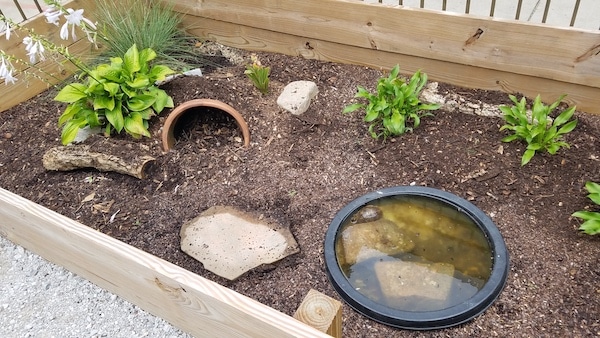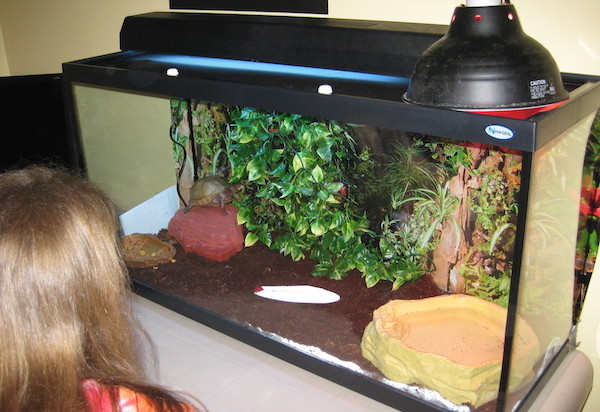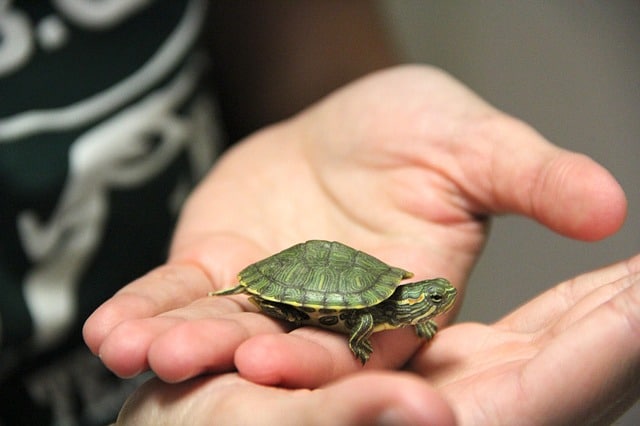
Turtles can be great pets to have. They can be curious and interact with you quite well. As pets, they are low maintenance and can live long lives if given the proper environment. Although they require minimal care, they do have some specific habitat needs to ensure they remain healthy and thrive well. As partially aquatic and cold-blood reptiles, their habitat needs to provide everything they need. This article will teach you how to set up a turtle habitat.
Tank Selection
An important aspect of your turtle’s habitat is going to be the tank you choose. There are a variety of options available, from pond-style surroundings to aquarium tanks. An aquarium tank is the most common choice.
The tank you choose should be able to hold water and provide enough separation between water and dry spots. Keep in mind that if you choose a smaller size tank with a younger turtle, you will eventually need to upgrade to a bigger tank as your turtle grows.
The tank size you choose should be specific to the size of your turtle. A general rule is to allow ten gallons of water for each inch of shell length. Shallow tanks should provide enough room in the water area for your turtle to swim around.
Additionally, if you opt to get a larger tank instead of one that is just big enough, make sure that you do not fill the water area too deep, especially for younger turtles. Hatchlings and really young turtles often do not have the lung capacity to survive in deeper water.
When filling the water area, the safest way to measure depth is by your turtle’s size. The water should be deep enough to allow for some swimming activity but still provide some room in case your turtle flips over accidentally. Ideally, the depth should be about one and half times your turtle’s length. This provides enough space for your turtle to flip back right side up if needed.
A variety of tank shapes are available as well. Shallow tanks are best suited for turtles that do not swim as well, including breeds such as Mud and Reeves turtles. Narrow tanks provide more vertical swimming room for strong swimmers such as Painted turtles.
Basking Space

The basking space will need to be separated from the water area. It is important to designate a basking space because your turtle cannot spend its whole life in the water. This area provides a dry space for your turtle to rest and allow its shell to dry. Make your basking space one and a half times the shell’s length. Docks are one of the best ways to provide a separate basking space. They can be suspended, floating, or above-tank.
Suspended docks attach to the side of the tank via suction and are made to sit on top of the water. These docks are ideal for turtles who have lower activity levels. Floating docks, such as fake rocks and driftwood, floats around the top of the water. Many people will use wood or large rocks found outside. If you pick things to use from the outdoors, they will need to be boiled to avoid introducing bacteria and algae that might be harmful to your turtle.
Above-tank basking areas require a bit more work. In most cases, these types of basking areas are not found easily from most pet shops and often require custom construction. You must take steps to ensure your turtle cannot escape from the tank area and that there is a ramp for easy access in and out of the water.
Tank Covers
The tank cover is an important safety measure. It not only ensures your turtle cannot escape, but it also makes sure that things cannot get into the tank. There are several species of turtles that are skilled escape artists and love to climb.
Metal link covers, also called screen covers, are the most common type. They allow for light and air to circulate into the tank. Avoid covers made from plastic and plexiglass because they prohibit the UV-B light your turtle needs and can also pose a fire hazard when using heat lamps.
Filters
In order to keep your tank water clean, you will need some sort of filtration system. You should choose a filter type that is designed for tanks about three times larger than the one you have. Canister filters, hanging filters, and submersible filters are all options.
Canister filters are often a popular choice for turtle habitats because they can typically handle the bioload output of a turtle better than others. Hanging filters require full tanks of water and using above-tank basking. Submersible filters struggle with keeping turtle water clean, requiring more frequent water changes.
Lighting

Turtles need lighting that closely matches the day-night cycle to help maintain their circadian sleep-wake cycles. You will need visible light that provides artificial daylight, UV-A light, and UV-B light.
A basking light also called a heat lamp, provides warmth in the basking area while also providing the light needed. Other compact lights can be used to mimic artificial daylight. Purchase bulbs that specify they provide UV-A and UV-B.
Heaters
Turtles cannot regulate their own temperature and that habitat should have two separate temperatures to help. Water temperature should be between 72 and 80 degrees Fahrenheit, while the basking area should be between 85 and 90 degrees Fahrenheit. To accomplish this, a water heater and heat lamp are necessary.
Water heaters can be submersible, under-substrate, and external. Submersible heaters attach to the tank and are kept submerged in the water. Under-substrate heaters are designed to sit under materials you have added to your tank such as sand or gravel. External heaters sit outside the tank and pump water from the tank into the heating element and then back out into the tank.
Substrates
Substrates are decorative and functional things you can add to the tank. They are added under the water, along the tank’s floor. If you intend on using living plants or you have a turtle that likes to dig, adding things such as gravel can be beneficial.
Gravel pieces should be at least an inch in diameter to prevent your turtle from curiously eating them. Avoid using glass, porcelain, or other materials that can easily be broken. Some turtles are overly curious and can break these items easily.
Turtle habitats help ensure adequate stimulation and proper living conditions. It helps provide the best environment for a healthy and happy turtle. Although each aspect of the habitat seems like a lot, once you get it set up, you are essentially done. Tank care is minimal, only requiring periodic cleaning with the proper setup.




